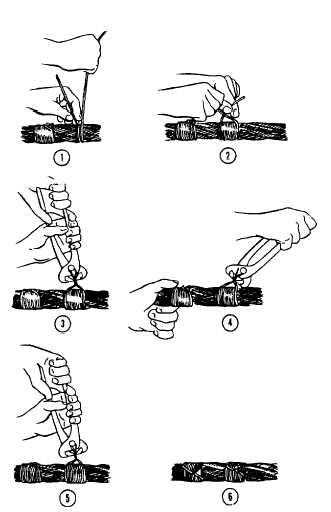| |
Operating over sheaves and drums with
improperly fitted groves or broken flanges
Jumping off sheaves
Subjecting to moisture or acid fumes
Attaching fittings improperly
Permitting to untwist
Subjecting to excessive heat
Promoting internal wear by allowing grit to
penetrate between the strands
Subjecting to severe or continuing overloads
Kinking
SEIZING WIRE ROPE
Seizing is the process of securing one rope to
another, two or more parts of the same rope to itself, or
fittings of any kind to a rope by binding with small stuff
or with annealed iron wire.
In the manufacture of wire rope, great care is taken
to lay each wire in the strand and each strand in the rope
under uniform tension. If the ends of the rope are not
secured properly, the original balance of tension will be
disturbed and maximum service will not be obtained
because some strands will carry a greater portion of the
load than others. Before cutting steel wire rope, you
must apply proper seizing on both sides of the place
where the cut is to be made. For preformed wire rope,
one seizing on each side is normally enough. For wire
ropes that are not preformed, a minimum of two seiz-
ings is required, placed six rope diameters apart.
Always apply seizing in the opposite direction from the
lay of the rope. This prevents loosening when the wire-
rope shrinks as a result of loading. Remember that the
length of the seizings must never be less than the
diameter of the wire rope being seized.
To make a temporary wire-rope seizing, wind on
the seizing wire uniformly, using strong tension on the
wire. After taking the required number of turns as
shown in step 1 in figure 3-31, twist the ends of the
wires counterclockwise as shown in step 2. Grasp the
ends with end-cutting nippers and twist up slack as
shown in step 3. Do not try to tighten the seizing by
twisting. Draw up on the seizing as shown in step 4.
Twist up slack Repeat steps 4 and 5 if needed. Cut the
ends and pound them down on the rope as shown in
step 6. If the seizing is to be permanent, or the rope is
1 5/8 inches or more in diameter, use a serving bar or
Figure 3-31.–Putting seizing on wire rope.
iron to increase tension on the seizing wire when putting
on the turns.
You must use the proper size and grade of wire for
seizing. Table 3-3 lists the proper sizes of seizing wire
for use with a range of wire-rope diameters.
Table 3-3.–Seizing for Wire Rope
Rope Diameter
Annealed Iron Seizing
(inches)
Wire Diameter (inches)
1/2 and smaller
0.035
9/16 to 7/8
.063
1 to 1 1/2
0.92
1 5/8 to 2 1/8
.120
2 1/4 and larger
.135
3-23
|

